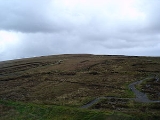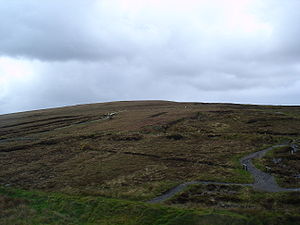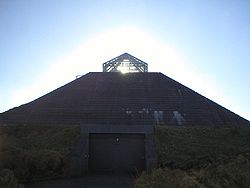
Céide Fields
Encyclopedia

County Mayo
County Mayo is a county in Ireland. It is located in the West Region and is also part of the province of Connacht. It is named after the village of Mayo, which is now generally known as Mayo Abbey. Mayo County Council is the local authority for the county. The population of the county is 130,552...
coast in the west of Ireland
Ireland
Ireland is an island to the northwest of continental Europe. It is the third-largest island in Europe and the twentieth-largest island on Earth...
, about 8 kilometres northwest of Ballycastle
Ballycastle, County Mayo
Ballycastle is a village in County Mayo, Ireland, situated northwest from Ballina, near Mayo's north coast in the West of Ireland. Ballycastle is also on the edge of an Irish speaking area called a Gaeltacht....
. The site is the most extensive Stone Age
Stone Age
The Stone Age is a broad prehistoric period, lasting about 2.5 million years , during which humans and their predecessor species in the genus Homo, as well as the earlier partly contemporary genera Australopithecus and Paranthropus, widely used exclusively stone as their hard material in the...
site in the world and contains the oldest known field systems in the world. Using various dating methods, it was discovered that the creation and development of the Céide Fields goes back some five and a half thousand years.
History
The discovery of the Céide Fields originally began in the 1930s when a local man, schoolteacherTeacher
A teacher or schoolteacher is a person who provides education for pupils and students . The role of teacher is often formal and ongoing, carried out at a school or other place of formal education. In many countries, a person who wishes to become a teacher must first obtain specified professional...
Patrick Caulfield, noticed piles of stones which were uncovered as he cut away turf for fuel. In these piles he saw some design which could not have been haphazard. Caulfield noted that the stones had to have been placed by people, because their configuration was clearly unnatural and deliberate. Furthermore, they were positioned below the bog
Bog
A bog, quagmire or mire is a wetland that accumulates acidic peat, a deposit of dead plant material—often mosses or, in Arctic climates, lichens....
, which meant they were there before the bog developed, implying a very ancient origin.
The unravelling of the true significance of this discovery did not begin for another forty years when Patrick's son, Seamus, having studied Archaeology
Archaeology
Archaeology, or archeology , is the study of human society, primarily through the recovery and analysis of the material culture and environmental data that they have left behind, which includes artifacts, architecture, biofacts and cultural landscapes...
, began to investigate further. Investigations revealed a complex of fields, houses and megalithic tombs concealed by the growth of blanket bog
Blanket bog
Blanket bog or blanket mire is an area of peatland, forming where there is a climate of high rainfall and a low level of evapotranspiration, allowing peat to develop not only in wet hollows but over large expanses of undulating ground. The blanketing of the ground with a variable depth of peat...
s over the course of many centuries.
Research and preservation

Economy
An economy consists of the economic system of a country or other area; the labor, capital and land resources; and the manufacturing, trade, distribution, and consumption of goods and services of that area...
was cattle rearing but they were skilled craftspeople and builders in both wood and stone and also had strong spiritual beliefs.
It was discovered that these people arrived in a land with a substantial forest canopy
Canopy (forest)
In biology, the canopy is the aboveground portion of a plant community or crop, formed by plant crowns.For forests, canopy also refers to the upper layer or habitat zone, formed by mature tree crowns and including other biological organisms .Sometimes the term canopy is used to refer to the extent...
. This was cleared to provide access to arable land
Arable land
In geography and agriculture, arable land is land that can be used for growing crops. It includes all land under temporary crops , temporary meadows for mowing or pasture, land under market and kitchen gardens and land temporarily fallow...
and to provide building material and firewood
Firewood
Firewood is any wood-like material that is gathered and used for fuel. Generally, firewood is not highly processed and is in some sort of recognizable log or branch form....
. This clearance continued onward and outward away from the area in continuing procurement of firewood.
The climate
Climate
Climate encompasses the statistics of temperature, humidity, atmospheric pressure, wind, rainfall, atmospheric particle count and other meteorological elemental measurements in a given region over long periods...
at the time was much warmer, leading to almost year-round growth potential. Samples taken from the remains of trees found in the bog provide ample evidence of this.
For a while, these people prospered, but some changes led to the development of raised bogs and the transformation of the arable land into barren and unusable land. It is speculated that the removal of the tree canopy helped cause this change. Where tree cover is substantial, most of the rain never reaches the ground. Instead it stays on the top of the canopy and is either absorbed or evaporates back into the atmosphere
Atmosphere
An atmosphere is a layer of gases that may surround a material body of sufficient mass, and that is held in place by the gravity of the body. An atmosphere may be retained for a longer duration, if the gravity is high and the atmosphere's temperature is low...
. With the removal of the forests, all of the rain reached the ground and, it is believed, leached the earth of its nutrients. This idea is supported by the presence of an ironpan
Bog iron
Bog iron refers to impure iron deposits that develop in bogs or swamps by the chemical or biochemical oxidation of iron carried in the solutions. In general, bog ores consist primarily of iron oxyhydroxides, commonly goethite...
in the sub-soil
Soil
Soil is a natural body consisting of layers of mineral constituents of variable thicknesses, which differ from the parent materials in their morphological, physical, chemical, and mineralogical characteristics...
over the area of the Céide Fields.
External links
- Céide Fields at Heritage Ireland
- Photo Gallery from Céide Fields
- Céide Fields web site
- Aerial view from Ordnance Survey of Ireland site

